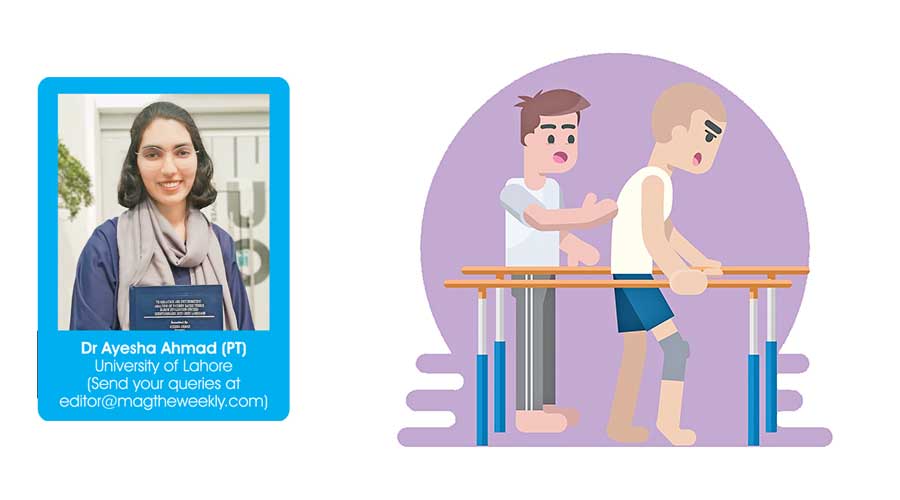ASK A PHYSICAL THERAPIST
- 13 Apr - 19 Apr, 2024

A: Bell’s Palsy causes sudden weakness/paralysis of the facial muscles due to swelling/inflammation of the facial nerve. It leads to drooping of eyelids and mouth, drooling, dryness of eyes, problems with eating and drinking, difficulty making expressions, etc.
It can occur at any age, although there is no definite cause it may be caused by viral infection. It is recoverable and the period varies from a few weeks to about 6 months. Physical therapy along with medications (prescribed after a checkup by a doctor) is recommended. A physical therapist applies specialized techniques for the condition. Facial massages are done as well as added to the home plan.
Exercises mostly include facial expressions (raising eyebrows, frowning, smiling, etc), blowing, sipping from a straw, chewing gum, holding a tongue depressor between lips, clenching teeth, etc. Make sure you use sunglasses to protect your eyes or use eye drops (prescribed).
A: Cerebral Palsy is a neurological condition that is non-progressive and caused by damage to the developing brain during fetal life (Infections, growth restrictions, vascular events), delivery (cord prolapse, obstructed labor, preterm delivery), neonatal life (Hypoxic ischemic encephalopathy, jaundice) or postnatal life (injury, metabolic disorders, meningitis). There may be some maternal factors like age, substance abuse and medications that can act as a cause.
The symptoms include postural and tonal abnormalities and persistent reflexes. Although a PT uses various scales for the condition, however, a CT scan and MRI may be required for the findings. Cerebral Palsy is divided into types including Spastic (there is increased tone and based on paralysis it is categorized as hemiplegia, diplegia, and quadriplegia), Hypotonic (Reduced tone), Dyskinetic (uncontrolled involuntary movement, rigidity, tremor), Ataxic (balance and coordination issues with weakness, incoordination, wide-based gait, and tremor)
A physical therapist evaluates the child and makes a comprehensive plan based on deficits (Musculoskeletal, Neuromotor, Sensory / Perceptual, Fine motor, Gross motor, and Oral motor). The physical therapist does not ignore the totality of the child hence he has a wide approach.
A team that may include a pediatrician, orthopedic, ophthalmologist, neurologist, physical therapist, orthotist/prosthetist, and speech and occupational therapist works with a child for helping him attain a maximum functional status.
Parents play a very crucial role and are properly guided throughout the journey. The condition requires a long commitment to physical therapy but is a good option for the child, moreover, it should be started as early as possible.
A: Headache may have several causes, here it may be arising from the cervical spine, or the surrounding muscles or there may be trigger points in tight muscles (commonly in the trapezius muscle). A physical therapist uses specialized techniques for muscle relaxation and joint mobilization to deal with the condition. Please make sure you use a normal pillow (neither too soft nor hard) to support your neck and that your mattress is firm. Ergonomic issues can also be a cause, use a table, with appropriate height to study and work at eye level. Also, get your eyesight checked. A student is a fighter but he can often get stressed, and try to stay relaxed and motivated.
A: Down Syndrome (Trisomy 21) is caused by a chromosomal disorder at the 21st chromosome leading to 47 chromosomes instead of 46. The condition can lead to musculoskeletal, cardiopulmonary, speech, auditory, visual, intellectual, and linear growth deficits and delays in development. Features include less brain weight as compared to the normal, flat face, small nose with nasal bridge depression, slanted eyelids, small mouth, narrow palate, furrowed shaped tongue, slightly protuberant abdomen, small hands and feet, single palmar crease, wide space between the first and second toe. The child often assumes W sitting.
A physical therapist designs comprehensive plans for the child and works in a team with other professionals for maximum results. A PT after proper assessment and evaluation works on gross and fine motor milestone achievement, antigravity control, postural reactions, and guides about proper handling and positioning of the child. He helps to facilitate the child in gaining maximum functional ability and independence.
COMMENTS